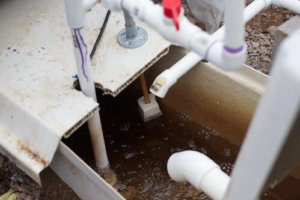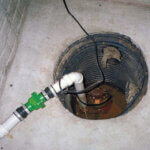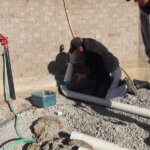How Does a Sump Pump Work?
Dealing with water damage is a nightmare no homeowner wants to experience. Unfortunately, it can happen, especially if your home has a basement that is prone to flooding. A sump pump can be a solution to this common problem, so read on to learn more about sump pumps and how they work.
What Does a Sump Pump Do?

A sump pump moves water from the basement to a designated outdoor space on your property. The name comes from the word “sump,” which is a pit dug beneath the main surface of the basement floor. The pit houses the pump, which includes valves that can sense rising moisture levels. When a sump pump is installed, the plumbers responsible for the installation process will determine where the water will drain on your property.
Some areas have regulations and codes that dictate where sump pumps can drain, so it’s important to follow these rules before designating a drainage point. Examples of drainage points include dry wells, ponds, and creeks. To achieve the ideal drainage point, a sump pump might need to be outfitted with a longer hose. It’s important to make sure the place you choose won’t allow the water to return to your home via gravity.
How Does a Sump Pump Work?
As mentioned, a sump pump has valves that can detect a change in moisture or water pressure around it. When it senses a change, such as a rising water level or an increase in pressure, it engages automatically, pumping the water out of the pit and to the designated drainage point. To work properly, the sump pump needs a discharge line, also called an effluent, that connects to the drainage area.
Sump pumps are typically installed in pits located in basements and crawl spaces, as these are the lowest points in homes. They have been fixtures in homes for many years, especially in areas where the quick melting of snow can lead to flooding or in low-lying parts of the country. If your home is at risk of flooding in the basement, a sump pump can save you a lot of money and frustration. A flooded basement can cause significant damage over a short period, and it doesn’t take much water to cause that damage.
Different Types of Sump Pumps
Homeowners can choose from four main types of sump pumps, and the right pump depends on your property and home setup. These types include submersible, pedestal, battery-operated backup, and water-powered backup pumps. A submersible sump pump includes both the motor and pump in a single unit. It sits submerged in a pit within the basement or crawl space. Submersible pumps tend to use less space and operate more quietly than pedestal pumps. They are also less likely to clog, but their constant submersion in water might shorten their life span.
A pedestal sump pump includes a separate motor and pump, with the motor sitting atop a pedestal above the pit, connected via a hose that runs to the pit where the pump sits. When it detects a change in water pressure or rising moisture levels, the pump pushes the water through the hose to the designated drainage point. Because the motor is not submerged in the pit, it is not exposed to water so it can last longer than a submersible pump. However, its position above the pit means it is usually louder when it runs.
A battery-operated backup pump provides added security against flood damage, as it includes a float switch that allows for proper operation, even when the power is out. Because many floods occur as the result of major storms, which can knock the power out at your home, having a battery backup can ensure the water from a storm is removed even while you wait for power to be restored.
A water-powered backup pump uses water pressure to clear the water that accumulates in the pit. This pump doesn’t need batteries or power, but the increased water usage can cause your bill to go up. Some cities and municipalities don’t allow for the installation of water-powered pumps, as they can be considered wasteful.
How to Know Your Home Needs a Sump Pump
If your home is prone to flooding, whether due to climate conditions, the placement of the structure on the property, or the location of your property, a sump pump is a necessary addition. A flood in your home can lead to expensive repairs as well as a number of health and safety concerns, including damage to the materials used to construct the residence, an increased risk of mold growth, and unpleasant odors in your living space.
An experienced plumber can assess your home and determine whether a sump pump would be a good addition to protect your space from the risks of flooding.
Signs a Sump Pump Needs Attention
If you have a sump pump in your home, it’s important to check it regularly to make sure it’s functioning properly and isn’t in need of repair or replacement. A sump pump might give off warning signs when it’s not working correctly. Some of these signs include loud operation, such as roaring or banging sounds, constant running, and irregular cycling.
If you notice these signs, contact a professional plumber to assess the pump’s condition and determine whether it can be repaired or needs to be replaced. In some cases, a minor problem with your pump, such as a clog or damaged component, can be repaired. However, sump pumps don’t last forever, and most manufacturers recommend replacement every 10 years or so. If your pump is nearing the end of its life span, a new sump pump might be the best solution.
At Allied Plumbing & Heating Supply Co., we offer sump pumps for clients in and around Chicago, Illinois. We’re leaders in high-quality sump pump options, and the best plumbers in the area rely on our wide selection of products when installing and replacing sump pumps for homeowners.
Image via Flickr by cogdogblog



